CHRYSLER VOYAGER 2001 Service Manual
Manufacturer: CHRYSLER, Model Year: 2001, Model line: VOYAGER, Model: CHRYSLER VOYAGER 2001Pages: 4284, PDF Size: 83.53 MB
Page 881 of 4284
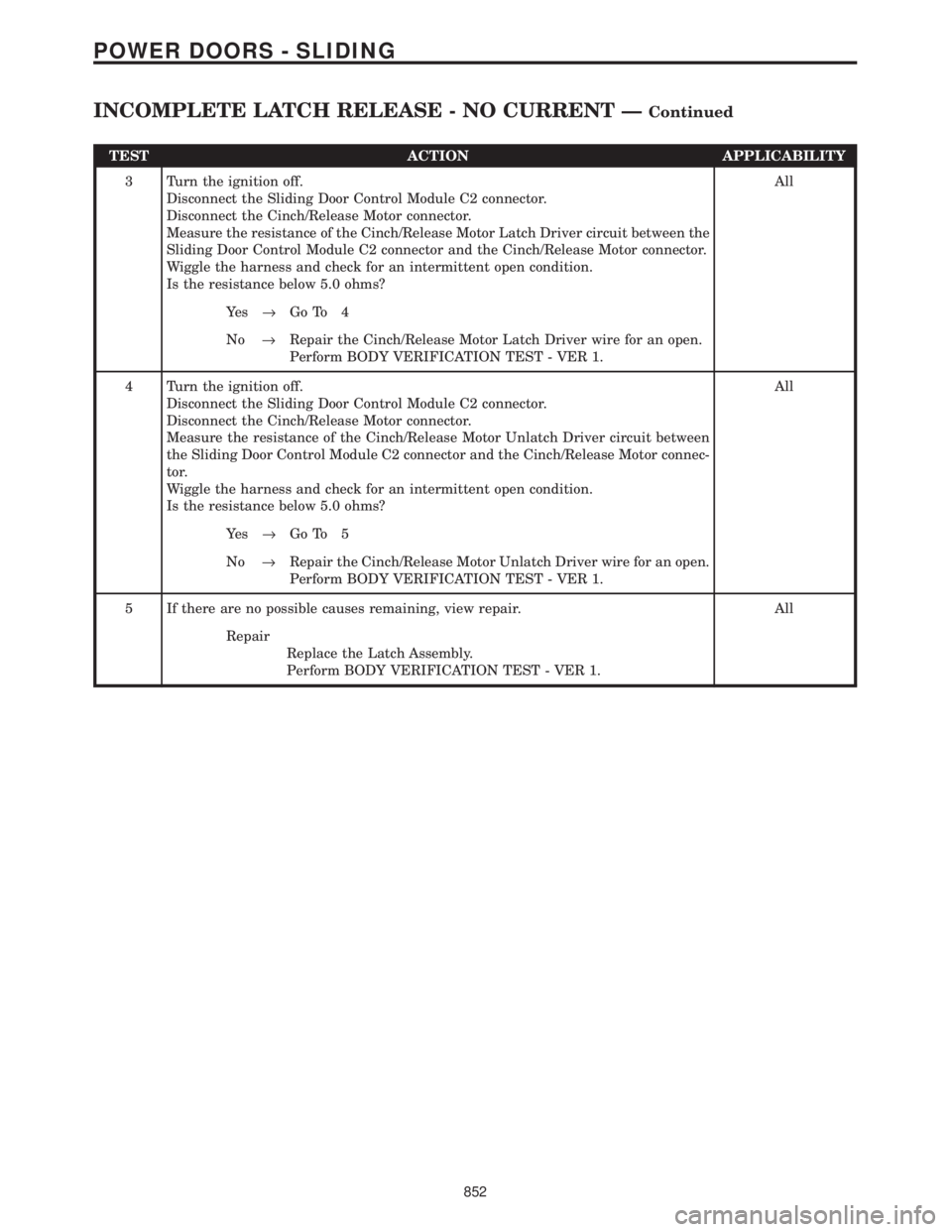
TEST ACTION APPLICABILITY
3 Turn the ignition off.
Disconnect the Sliding Door Control Module C2 connector.
Disconnect the Cinch/Release Motor connector.
Measure the resistance of the Cinch/Release Motor Latch Driver circuit between the
Sliding Door Control Module C2 connector and the Cinch/Release Motor connector.
Wiggle the harness and check for an intermittent open condition.
Is the resistance below 5.0 ohms?All
Ye s®Go To 4
No®Repair the Cinch/Release Motor Latch Driver wire for an open.
Perform BODY VERIFICATION TEST - VER 1.
4 Turn the ignition off.
Disconnect the Sliding Door Control Module C2 connector.
Disconnect the Cinch/Release Motor connector.
Measure the resistance of the Cinch/Release Motor Unlatch Driver circuit between
the Sliding Door Control Module C2 connector and the Cinch/Release Motor connec-
tor.
Wiggle the harness and check for an intermittent open condition.
Is the resistance below 5.0 ohms?All
Ye s®Go To 5
No®Repair the Cinch/Release Motor Unlatch Driver wire for an open.
Perform BODY VERIFICATION TEST - VER 1.
5 If there are no possible causes remaining, view repair. All
Repair
Replace the Latch Assembly.
Perform BODY VERIFICATION TEST - VER 1.
852
POWER DOORS - SLIDING
INCOMPLETE LATCH RELEASE - NO CURRENT ÐContinued
Page 882 of 4284

Symptom:
INCOMPLETE LATCH RELEASE - RATCHET SWITCH FAILURE
When Monitored and Set Condition:
INCOMPLETE LATCH RELEASE - RATCHET SWITCH FAILURE
When Monitored: Whenever the power sliding door is operating in an opening direction.
Set Condition: The release operation was not completed in 4 seconds or a stall condition
was detected in the release operation. The pawl switch was grounded but the ratchet
switch remained open. This code will set only in the release operation.
POSSIBLE CAUSES
DTC PRESENT
BINDING DOOR
POWER SLIDING DOOR MODULE - RATCHET CIRCUIT
GROUND WIRE OPEN
SLIDING DOOR AJAR SWITCH SENSE WIRE OPEN
RATCHET SWITCH
TEST ACTION APPLICABILITY
1NOTE: This DTC will only set during the cinching operation after the 4
second time out. This may make it difficult to reproduce
With the DRBIIIt, record and erase DTC's.
Turn the ignition off, wait 10 seconds, then turn the ignition on.
Operate the power sliding door several times if possible.
With the DRBIIIt, read ACTIVE DTCs.
Does the DRBIIItdisplay INCOMPLETE LATCH RELEASE - RATCHET SWITCH
FAILURE?All
Ye s®Go To 2
No®Using the wiring diagram/schematic as a guide, inspect the
wiring and connectors for an intermittent condition. Operate the
door several times and check for any binding or other obstruc-
tions.
Perform BODY VERIFICATION TEST - VER 1.
2 Examine the door for proper fit and alignment, loose/ hard or torn seals, worn teeth
on the rack and gear (lower drive unit) or anything that would cause an obstruction
to proper operation.
Manually operate the other sliding door or of a known good vehicle and notice the
effort needed to open and close.
Compare the effort needed on the disabled door.
Especially notice the effort needed to unlatch and close the door.
Does it take more effort to operate the door than it should?All
Ye s®Refer to Service information for the related symptom(s).
Perform BODY VERIFICATION TEST - VER 1.
No®Go To 3
853
POWER DOORS - SLIDING
Page 883 of 4284
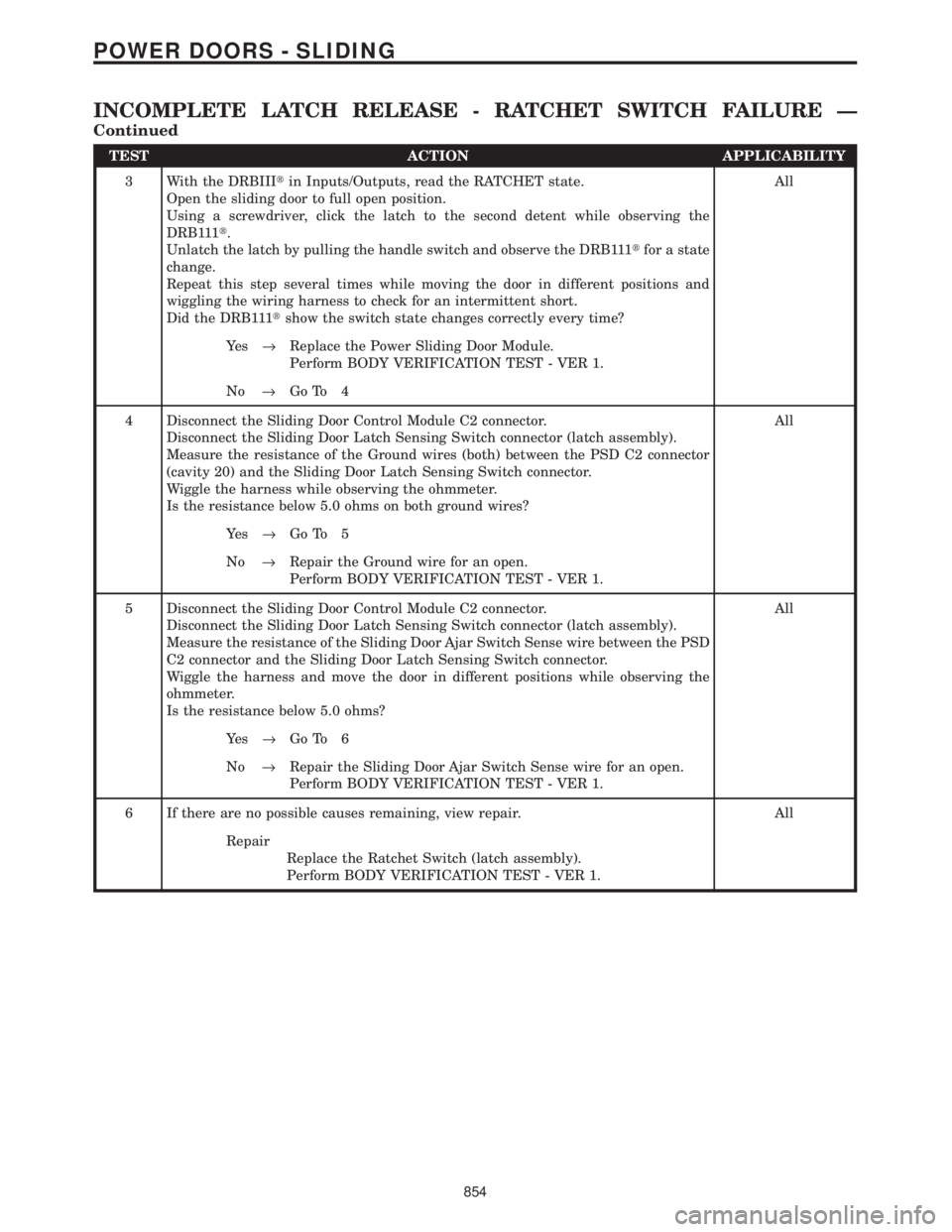
TEST ACTION APPLICABILITY
3 With the DRBIIItin Inputs/Outputs, read the RATCHET state.
Open the sliding door to full open position.
Using a screwdriver, click the latch to the second detent while observing the
DRB111t.
Unlatch the latch by pulling the handle switch and observe the DRB111tfor a state
change.
Repeat this step several times while moving the door in different positions and
wiggling the wiring harness to check for an intermittent short.
Did the DRB111tshow the switch state changes correctly every time?All
Ye s®Replace the Power Sliding Door Module.
Perform BODY VERIFICATION TEST - VER 1.
No®Go To 4
4 Disconnect the Sliding Door Control Module C2 connector.
Disconnect the Sliding Door Latch Sensing Switch connector (latch assembly).
Measure the resistance of the Ground wires (both) between the PSD C2 connector
(cavity 20) and the Sliding Door Latch Sensing Switch connector.
Wiggle the harness while observing the ohmmeter.
Is the resistance below 5.0 ohms on both ground wires?All
Ye s®Go To 5
No®Repair the Ground wire for an open.
Perform BODY VERIFICATION TEST - VER 1.
5 Disconnect the Sliding Door Control Module C2 connector.
Disconnect the Sliding Door Latch Sensing Switch connector (latch assembly).
Measure the resistance of the Sliding Door Ajar Switch Sense wire between the PSD
C2 connector and the Sliding Door Latch Sensing Switch connector.
Wiggle the harness and move the door in different positions while observing the
ohmmeter.
Is the resistance below 5.0 ohms?All
Ye s®Go To 6
No®Repair the Sliding Door Ajar Switch Sense wire for an open.
Perform BODY VERIFICATION TEST - VER 1.
6 If there are no possible causes remaining, view repair. All
Repair
Replace the Ratchet Switch (latch assembly).
Perform BODY VERIFICATION TEST - VER 1.
854
POWER DOORS - SLIDING
INCOMPLETE LATCH RELEASE - RATCHET SWITCH FAILURE Ð
Continued
Page 884 of 4284
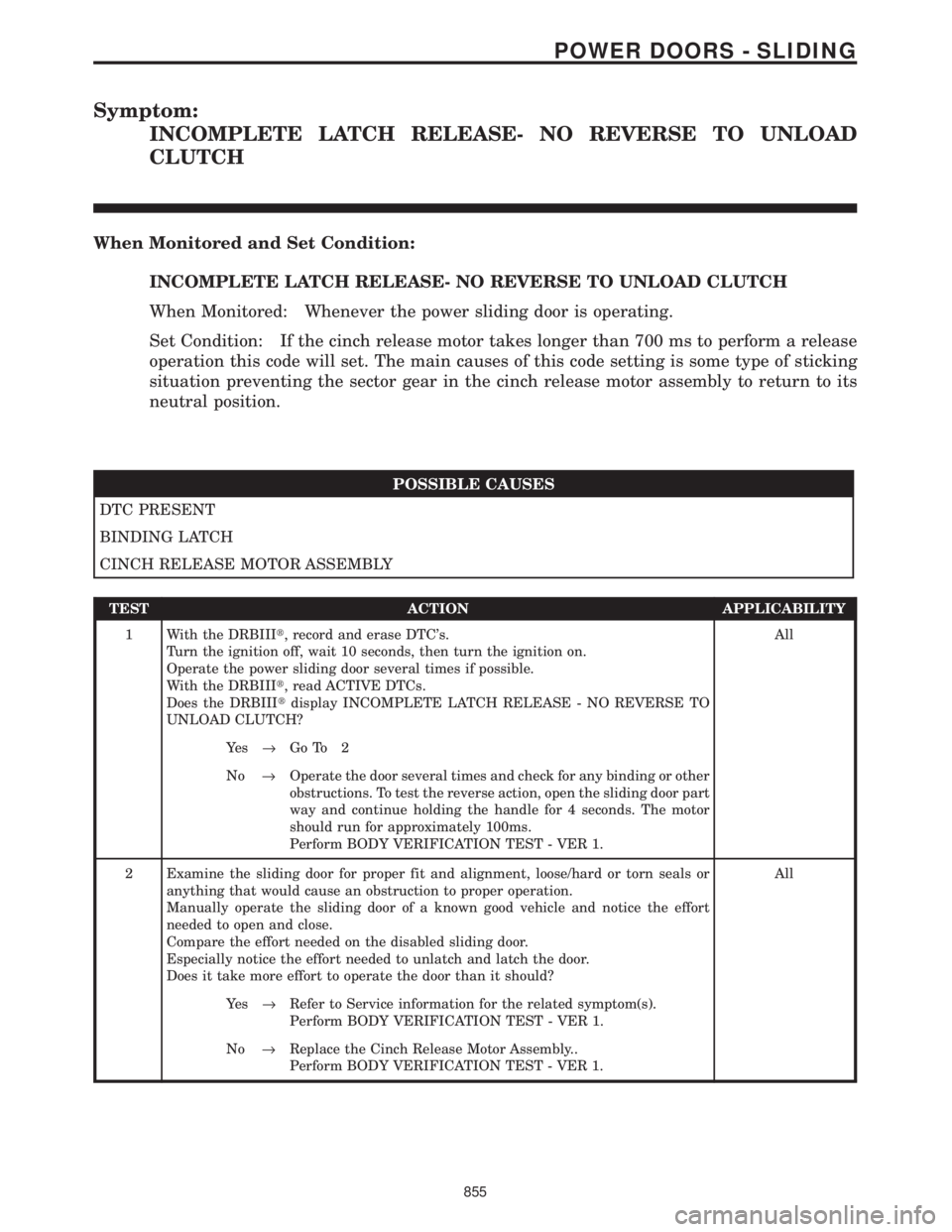
Symptom:
INCOMPLETE LATCH RELEASE- NO REVERSE TO UNLOAD
CLUTCH
When Monitored and Set Condition:
INCOMPLETE LATCH RELEASE- NO REVERSE TO UNLOAD CLUTCH
When Monitored: Whenever the power sliding door is operating.
Set Condition: If the cinch release motor takes longer than 700 ms to perform a release
operation this code will set. The main causes of this code setting is some type of sticking
situation preventing the sector gear in the cinch release motor assembly to return to its
neutral position.
POSSIBLE CAUSES
DTC PRESENT
BINDING LATCH
CINCH RELEASE MOTOR ASSEMBLY
TEST ACTION APPLICABILITY
1 With the DRBIIIt, record and erase DTC's.
Turn the ignition off, wait 10 seconds, then turn the ignition on.
Operate the power sliding door several times if possible.
With the DRBIIIt, read ACTIVE DTCs.
Does the DRBIIItdisplay INCOMPLETE LATCH RELEASE - NO REVERSE TO
UNLOAD CLUTCH?All
Ye s®Go To 2
No®Operate the door several times and check for any binding or other
obstructions. To test the reverse action, open the sliding door part
way and continue holding the handle for 4 seconds. The motor
should run for approximately 100ms.
Perform BODY VERIFICATION TEST - VER 1.
2 Examine the sliding door for proper fit and alignment, loose/hard or torn seals or
anything that would cause an obstruction to proper operation.
Manually operate the sliding door of a known good vehicle and notice the effort
needed to open and close.
Compare the effort needed on the disabled sliding door.
Especially notice the effort needed to unlatch and latch the door.
Does it take more effort to operate the door than it should?All
Ye s®Refer to Service information for the related symptom(s).
Perform BODY VERIFICATION TEST - VER 1.
No®Replace the Cinch Release Motor Assembly..
Perform BODY VERIFICATION TEST - VER 1.
855
POWER DOORS - SLIDING
Page 885 of 4284
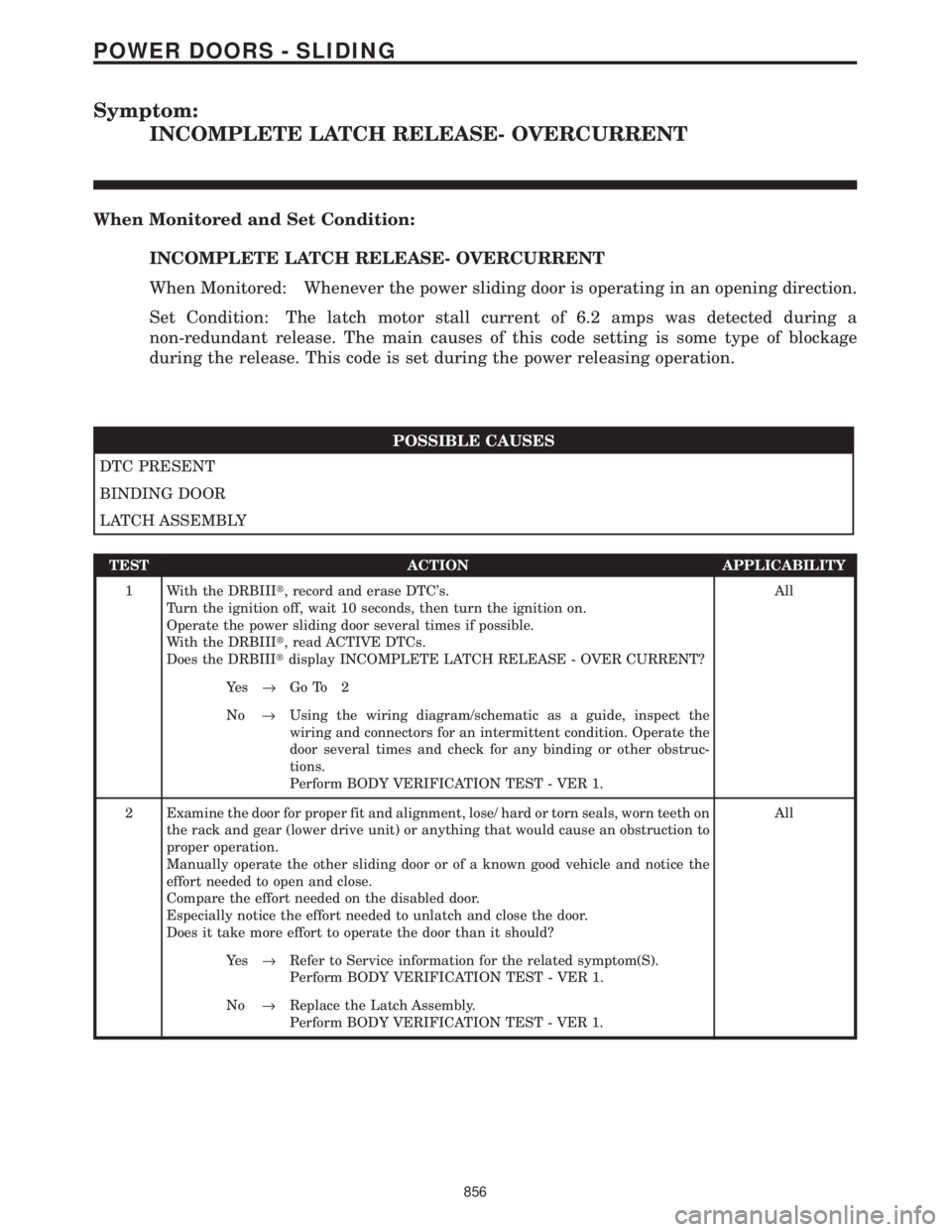
Symptom:
INCOMPLETE LATCH RELEASE- OVERCURRENT
When Monitored and Set Condition:
INCOMPLETE LATCH RELEASE- OVERCURRENT
When Monitored: Whenever the power sliding door is operating in an opening direction.
Set Condition: The latch motor stall current of 6.2 amps was detected during a
non-redundant release. The main causes of this code setting is some type of blockage
during the release. This code is set during the power releasing operation.
POSSIBLE CAUSES
DTC PRESENT
BINDING DOOR
LATCH ASSEMBLY
TEST ACTION APPLICABILITY
1 With the DRBIIIt, record and erase DTC's.
Turn the ignition off, wait 10 seconds, then turn the ignition on.
Operate the power sliding door several times if possible.
With the DRBIIIt, read ACTIVE DTCs.
Does the DRBIIItdisplay INCOMPLETE LATCH RELEASE - OVER CURRENT?All
Ye s®Go To 2
No®Using the wiring diagram/schematic as a guide, inspect the
wiring and connectors for an intermittent condition. Operate the
door several times and check for any binding or other obstruc-
tions.
Perform BODY VERIFICATION TEST - VER 1.
2 Examine the door for proper fit and alignment, lose/ hard or torn seals, worn teeth on
the rack and gear (lower drive unit) or anything that would cause an obstruction to
proper operation.
Manually operate the other sliding door or of a known good vehicle and notice the
effort needed to open and close.
Compare the effort needed on the disabled door.
Especially notice the effort needed to unlatch and close the door.
Does it take more effort to operate the door than it should?All
Ye s®Refer to Service information for the related symptom(S).
Perform BODY VERIFICATION TEST - VER 1.
No®Replace the Latch Assembly.
Perform BODY VERIFICATION TEST - VER 1.
856
POWER DOORS - SLIDING
Page 886 of 4284
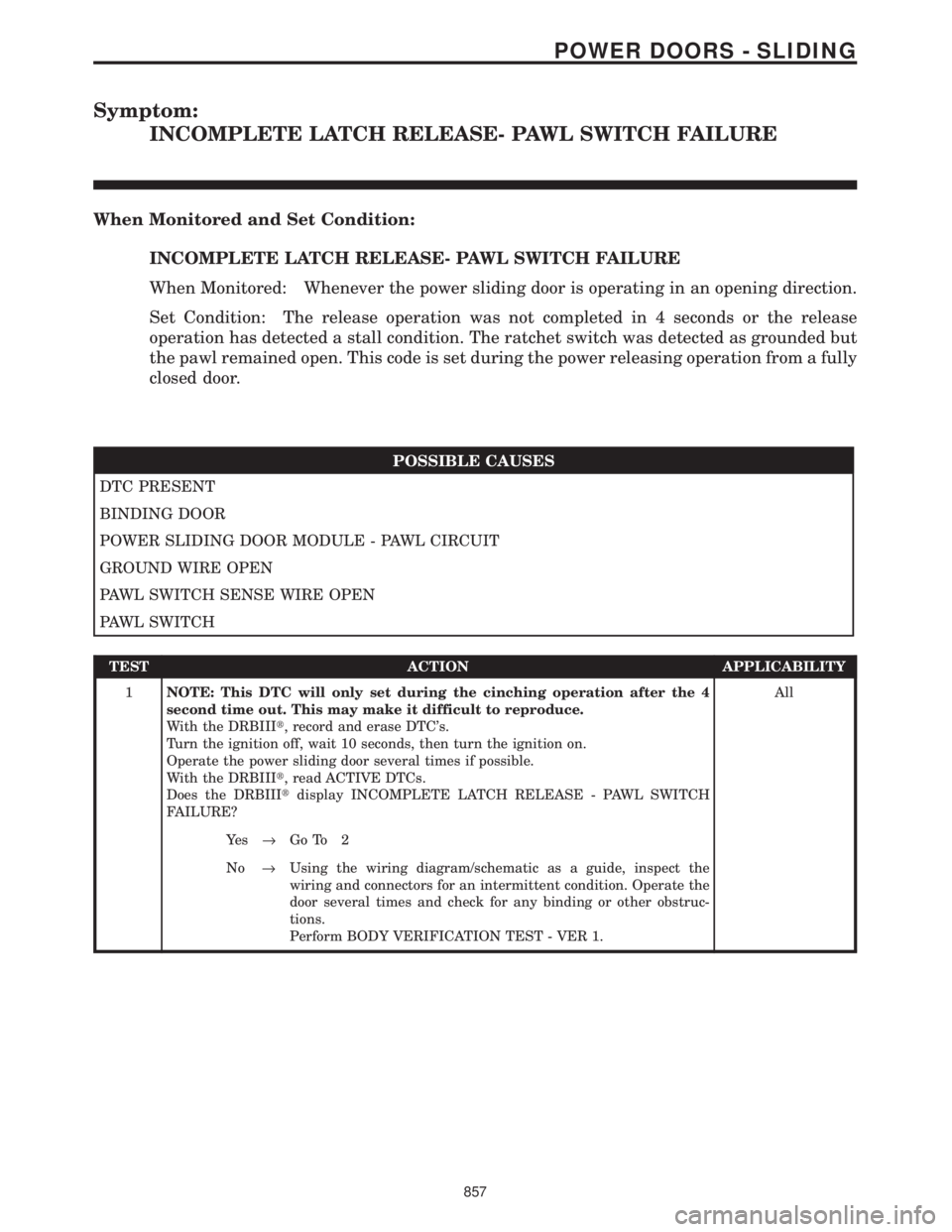
Symptom:
INCOMPLETE LATCH RELEASE- PAWL SWITCH FAILURE
When Monitored and Set Condition:
INCOMPLETE LATCH RELEASE- PAWL SWITCH FAILURE
When Monitored: Whenever the power sliding door is operating in an opening direction.
Set Condition: The release operation was not completed in 4 seconds or the release
operation has detected a stall condition. The ratchet switch was detected as grounded but
the pawl remained open. This code is set during the power releasing operation from a fully
closed door.
POSSIBLE CAUSES
DTC PRESENT
BINDING DOOR
POWER SLIDING DOOR MODULE - PAWL CIRCUIT
GROUND WIRE OPEN
PAWL SWITCH SENSE WIRE OPEN
PAWL SWITCH
TEST ACTION APPLICABILITY
1NOTE: This DTC will only set during the cinching operation after the 4
second time out. This may make it difficult to reproduce.
With the DRBIIIt, record and erase DTC's.
Turn the ignition off, wait 10 seconds, then turn the ignition on.
Operate the power sliding door several times if possible.
With the DRBIIIt, read ACTIVE DTCs.
Does the DRBIIItdisplay INCOMPLETE LATCH RELEASE - PAWL SWITCH
FAILURE?All
Ye s®Go To 2
No®Using the wiring diagram/schematic as a guide, inspect the
wiring and connectors for an intermittent condition. Operate the
door several times and check for any binding or other obstruc-
tions.
Perform BODY VERIFICATION TEST - VER 1.
857
POWER DOORS - SLIDING
Page 887 of 4284
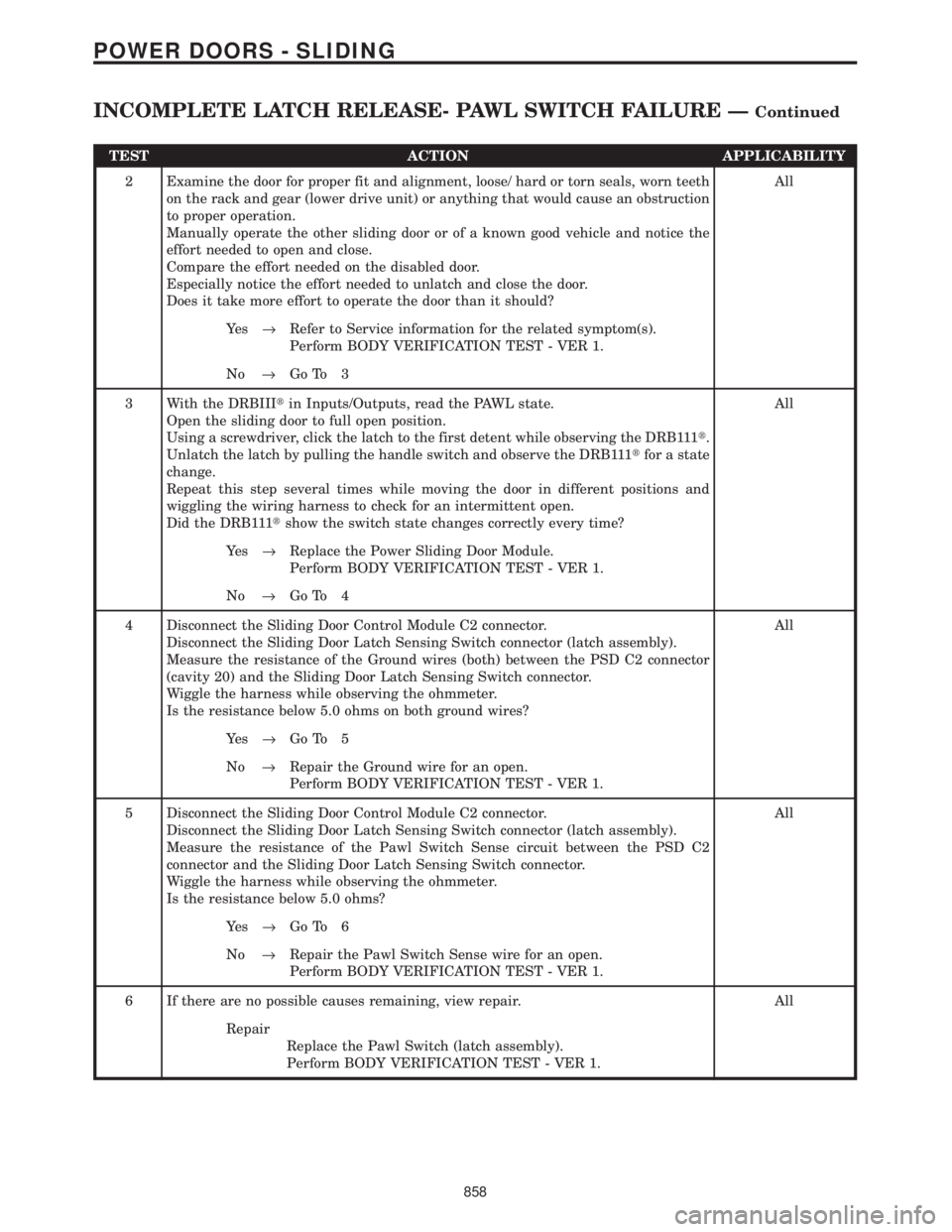
TEST ACTION APPLICABILITY
2 Examine the door for proper fit and alignment, loose/ hard or torn seals, worn teeth
on the rack and gear (lower drive unit) or anything that would cause an obstruction
to proper operation.
Manually operate the other sliding door or of a known good vehicle and notice the
effort needed to open and close.
Compare the effort needed on the disabled door.
Especially notice the effort needed to unlatch and close the door.
Does it take more effort to operate the door than it should?All
Ye s®Refer to Service information for the related symptom(s).
Perform BODY VERIFICATION TEST - VER 1.
No®Go To 3
3 With the DRBIIItin Inputs/Outputs, read the PAWL state.
Open the sliding door to full open position.
Using a screwdriver, click the latch to the first detent while observing the DRB111t.
Unlatch the latch by pulling the handle switch and observe the DRB111tfor a state
change.
Repeat this step several times while moving the door in different positions and
wiggling the wiring harness to check for an intermittent open.
Did the DRB111tshow the switch state changes correctly every time?All
Ye s®Replace the Power Sliding Door Module.
Perform BODY VERIFICATION TEST - VER 1.
No®Go To 4
4 Disconnect the Sliding Door Control Module C2 connector.
Disconnect the Sliding Door Latch Sensing Switch connector (latch assembly).
Measure the resistance of the Ground wires (both) between the PSD C2 connector
(cavity 20) and the Sliding Door Latch Sensing Switch connector.
Wiggle the harness while observing the ohmmeter.
Is the resistance below 5.0 ohms on both ground wires?All
Ye s®Go To 5
No®Repair the Ground wire for an open.
Perform BODY VERIFICATION TEST - VER 1.
5 Disconnect the Sliding Door Control Module C2 connector.
Disconnect the Sliding Door Latch Sensing Switch connector (latch assembly).
Measure the resistance of the Pawl Switch Sense circuit between the PSD C2
connector and the Sliding Door Latch Sensing Switch connector.
Wiggle the harness while observing the ohmmeter.
Is the resistance below 5.0 ohms?All
Ye s®Go To 6
No®Repair the Pawl Switch Sense wire for an open.
Perform BODY VERIFICATION TEST - VER 1.
6 If there are no possible causes remaining, view repair. All
Repair
Replace the Pawl Switch (latch assembly).
Perform BODY VERIFICATION TEST - VER 1.
858
POWER DOORS - SLIDING
INCOMPLETE LATCH RELEASE- PAWL SWITCH FAILURE ÐContinued
Page 888 of 4284
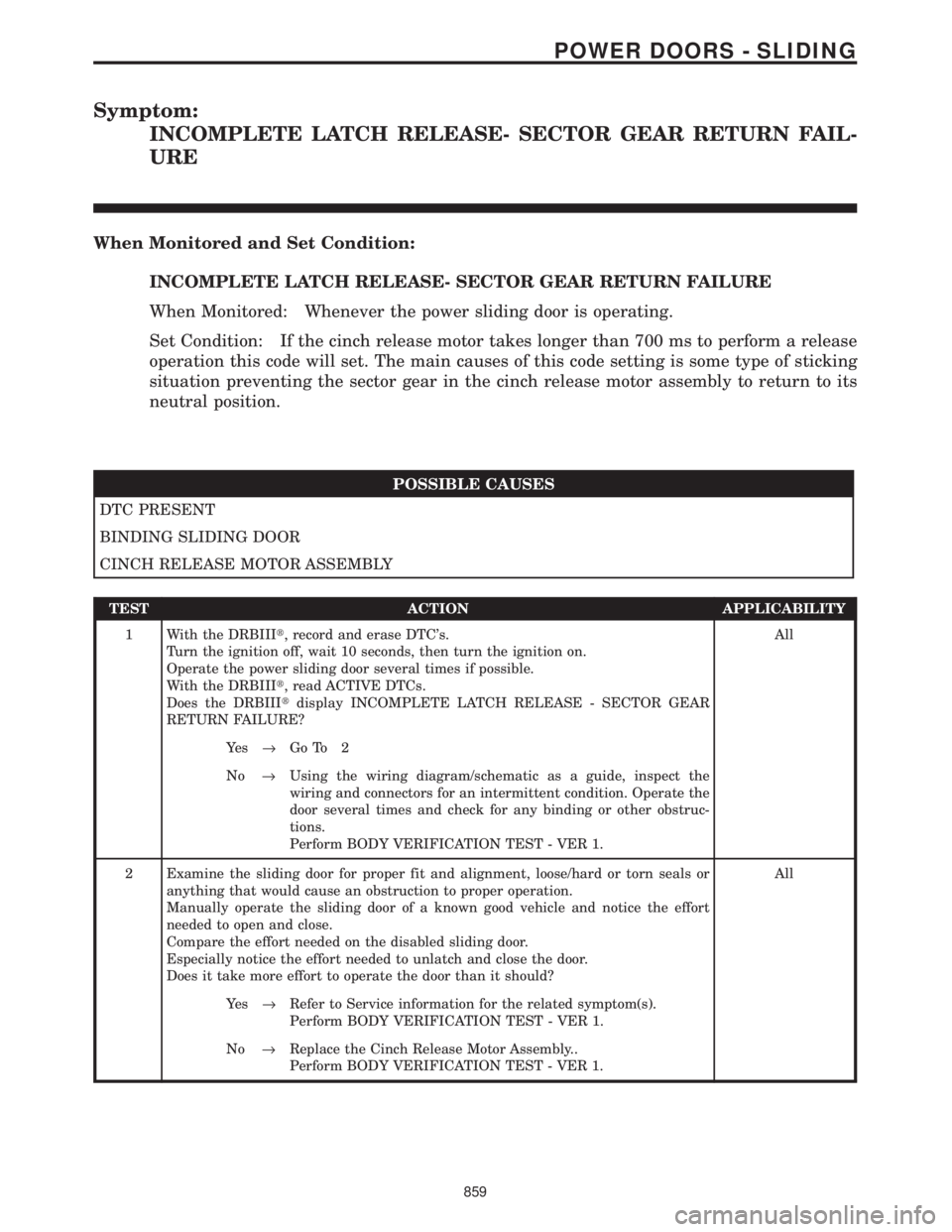
Symptom:
INCOMPLETE LATCH RELEASE- SECTOR GEAR RETURN FAIL-
URE
When Monitored and Set Condition:
INCOMPLETE LATCH RELEASE- SECTOR GEAR RETURN FAILURE
When Monitored: Whenever the power sliding door is operating.
Set Condition: If the cinch release motor takes longer than 700 ms to perform a release
operation this code will set. The main causes of this code setting is some type of sticking
situation preventing the sector gear in the cinch release motor assembly to return to its
neutral position.
POSSIBLE CAUSES
DTC PRESENT
BINDING SLIDING DOOR
CINCH RELEASE MOTOR ASSEMBLY
TEST ACTION APPLICABILITY
1 With the DRBIIIt, record and erase DTC's.
Turn the ignition off, wait 10 seconds, then turn the ignition on.
Operate the power sliding door several times if possible.
With the DRBIIIt, read ACTIVE DTCs.
Does the DRBIIItdisplay INCOMPLETE LATCH RELEASE - SECTOR GEAR
RETURN FAILURE?All
Ye s®Go To 2
No®Using the wiring diagram/schematic as a guide, inspect the
wiring and connectors for an intermittent condition. Operate the
door several times and check for any binding or other obstruc-
tions.
Perform BODY VERIFICATION TEST - VER 1.
2 Examine the sliding door for proper fit and alignment, loose/hard or torn seals or
anything that would cause an obstruction to proper operation.
Manually operate the sliding door of a known good vehicle and notice the effort
needed to open and close.
Compare the effort needed on the disabled sliding door.
Especially notice the effort needed to unlatch and close the door.
Does it take more effort to operate the door than it should?All
Ye s®Refer to Service information for the related symptom(s).
Perform BODY VERIFICATION TEST - VER 1.
No®Replace the Cinch Release Motor Assembly..
Perform BODY VERIFICATION TEST - VER 1.
859
POWER DOORS - SLIDING
Page 889 of 4284
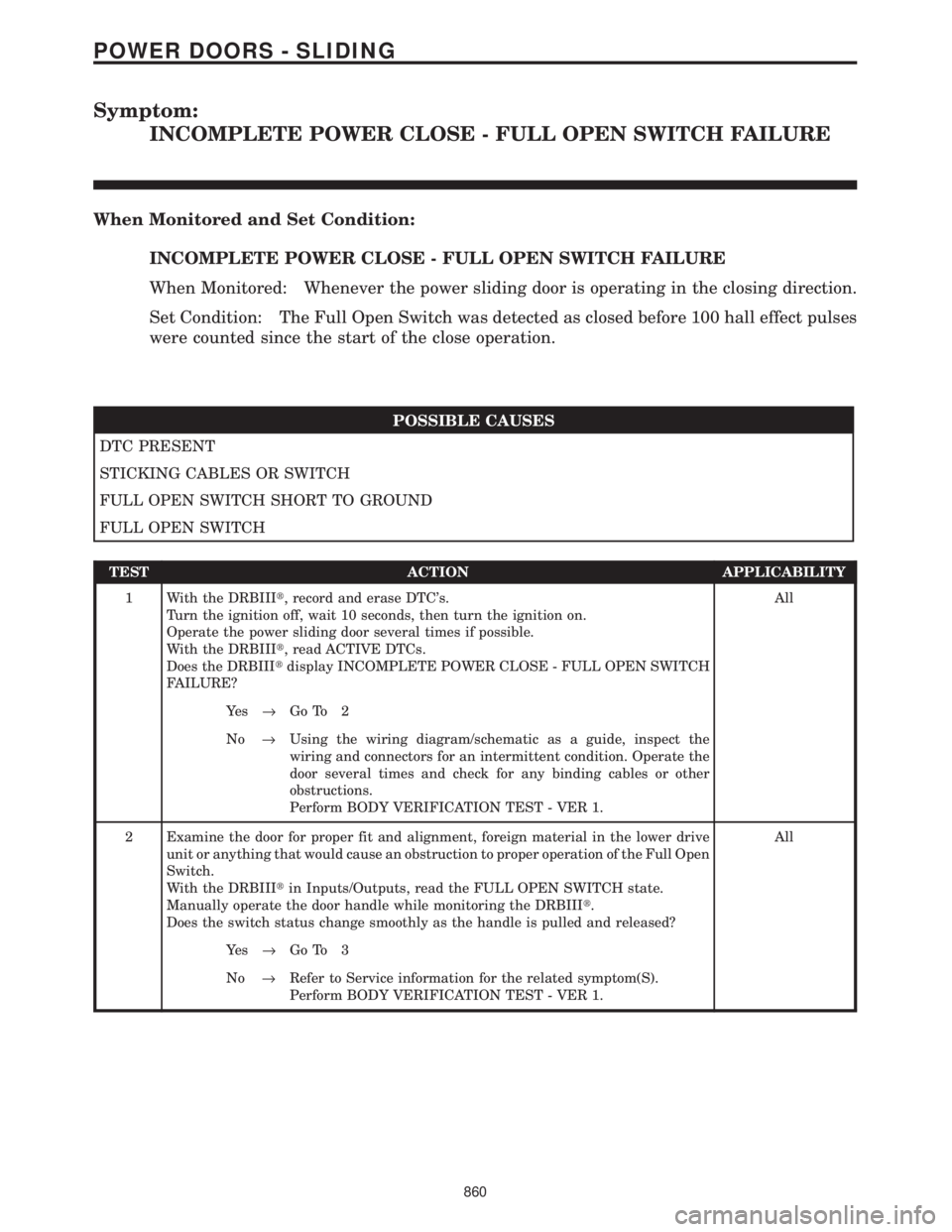
Symptom:
INCOMPLETE POWER CLOSE - FULL OPEN SWITCH FAILURE
When Monitored and Set Condition:
INCOMPLETE POWER CLOSE - FULL OPEN SWITCH FAILURE
When Monitored: Whenever the power sliding door is operating in the closing direction.
Set Condition: The Full Open Switch was detected as closed before 100 hall effect pulses
were counted since the start of the close operation.
POSSIBLE CAUSES
DTC PRESENT
STICKING CABLES OR SWITCH
FULL OPEN SWITCH SHORT TO GROUND
FULL OPEN SWITCH
TEST ACTION APPLICABILITY
1 With the DRBIIIt, record and erase DTC's.
Turn the ignition off, wait 10 seconds, then turn the ignition on.
Operate the power sliding door several times if possible.
With the DRBIIIt, read ACTIVE DTCs.
Does the DRBIIItdisplay INCOMPLETE POWER CLOSE - FULL OPEN SWITCH
FAILURE?All
Ye s®Go To 2
No®Using the wiring diagram/schematic as a guide, inspect the
wiring and connectors for an intermittent condition. Operate the
door several times and check for any binding cables or other
obstructions.
Perform BODY VERIFICATION TEST - VER 1.
2 Examine the door for proper fit and alignment, foreign material in the lower drive
unit or anything that would cause an obstruction to proper operation of the Full Open
Switch.
With the DRBIIItin Inputs/Outputs, read the FULL OPEN SWITCH state.
Manually operate the door handle while monitoring the DRBIIIt.
Does the switch status change smoothly as the handle is pulled and released?All
Ye s®Go To 3
No®Refer to Service information for the related symptom(S).
Perform BODY VERIFICATION TEST - VER 1.
860
POWER DOORS - SLIDING
Page 890 of 4284
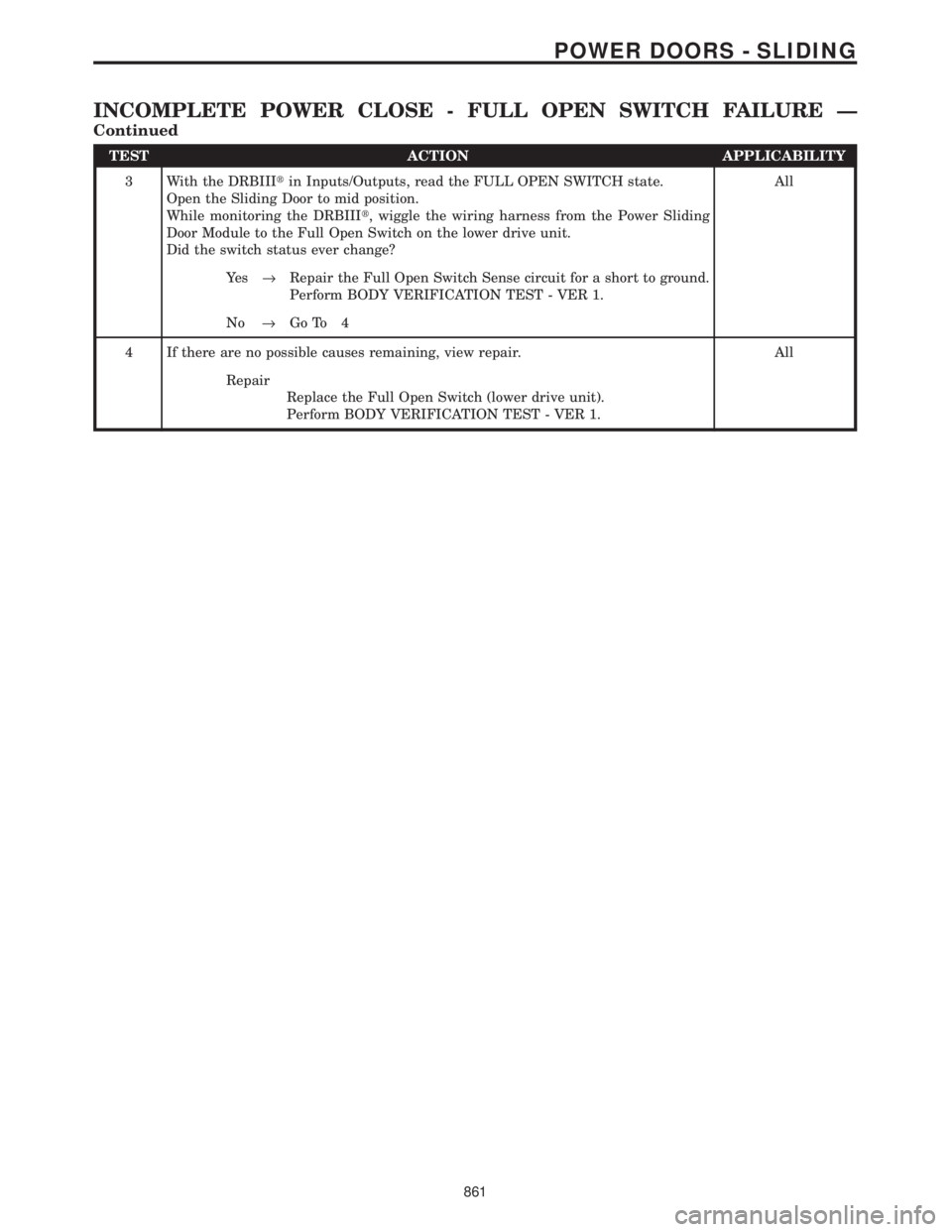
TEST ACTION APPLICABILITY
3 With the DRBIIItin Inputs/Outputs, read the FULL OPEN SWITCH state.
Open the Sliding Door to mid position.
While monitoring the DRBIIIt, wiggle the wiring harness from the Power Sliding
Door Module to the Full Open Switch on the lower drive unit.
Did the switch status ever change?All
Ye s®Repair the Full Open Switch Sense circuit for a short to ground.
Perform BODY VERIFICATION TEST - VER 1.
No®Go To 4
4 If there are no possible causes remaining, view repair. All
Repair
Replace the Full Open Switch (lower drive unit).
Perform BODY VERIFICATION TEST - VER 1.
861
POWER DOORS - SLIDING
INCOMPLETE POWER CLOSE - FULL OPEN SWITCH FAILURE Ð
Continued